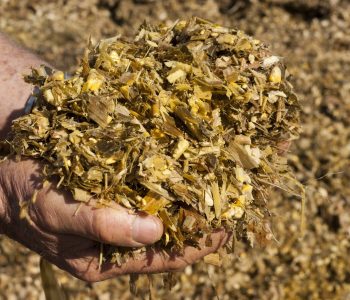TMR silage: possibilities and limitation for on farm application
The process of ensiling total mixed rations (TMR) is not a new concept. There has been a growing interest in the utilization of ensiled TMR in various countries, particularly in Asian nations, as a means to efficiently utilize moist by-products. In Brazil, this approach has captured attention in recent times.
Source: Picture provided by the authors
TMR silage is obtained by storing a blend of ingredients under anaerobic conditions. Including:
The mixture of all these dietary components should provide the necessary nutrients for animals to meet their maintenance and production requirements.
In the available literature (Restelatto et al., 2019; Lazzari et al., 2021) on this topic, certain advantages have been linked to the utilization of ensiled TMR, which encompass:
- Reduced labor in daily routines;
- Concentration of machinery use over a few days when preparing the diet on the farm, eliminating daily mixing in feeding management activities (preventing mixing errors throughout the year);
- Uniformity of mixture and diet composition;
- Precision in feeding;
- Reduced particle selection during animal feeding, due to the redistribution of moisture that occurs in the material during storage in the silo;
- Reduced waste;
- Minimal dry matter losses from the ensiled material;
- Efficient preservation of a wide variety of forages and by-products with high moisture content;
- Greater resistance to aerobic deterioration compared to fresh TMR;
- Optimization of time in animal management practices.
On the farm, it is possible to ensile TMR using a mixer wagon and store it in trench silos,. Additionally, the choice of using bag-type silos for ensiling TMR can be influenced by the herd’s size (number of animals).
Source: Picture provided by the authors
The challenge faced by producers when deciding to produce ensiled TMR is the high initial cost of purchasing the ingredients. However, the preparation and ensilage of TMR can be planned to occur gradually throughout the year, without the need to prepare all TMR silage at once.
This planning facilitates the purchase of ingredients at strategic times with more favorable prices. Alternatively, producers who do not wish to invest in machinery can purchase ensiled TMR from specialized industries.
Nutritionally, it is worth noting that ensiling TMR enhances:
- The breakdown of the protein matrix enveloping starch granules in the endosperm during the storage period of the ensiled material which primarily leads to increased starch digestibility in cereal grains.
As a result, ensiling TMR, including cereal grains, improves feed efficiency and animal performance. On the other hand, there may be an increase in ruminal protein degradability due to proteolysis during storage (Lazzari et al., 2021).
However, the nutritional changes during the storage of TMR silage in the silo are not fully understood due to the wide variety of available ingredients for diet formulation. Nevertheless, some nutrient modifications in ensiled TMR diets are already available in the literature.
| The Silage and Hay Study Group (GESF) at the State University of Maringá has conducted research to understand these nutrient modifications in ensiled diets (Bueno et al., 2020; Lazzari et al., 2021). |
A study conducted by this study group evaluated the performance of heifers fed ensiled TMR, testing different protein sources and lipid supplementation. Researchers found that animal performance was significantly improved when soybean meal was replaced by whole soybeans, a source that combines proteins and lipids.
As previously mentioned, the inclusion of lipid sources in the supplementation of beef cattle during the finishing phase generally enhances both average daily gain (ADG) and feed efficiency.
This occurs because fat has a net energy for gain (NEg) value approximately 3 times higher compared to corn (NASEM, 2016).
Source: Picture provided by the authors
Nonetheless, in the research conducted by Lazzari et al. (2021), ensiled TMR, where whole soybeans served as both the source of lipids and proteins, did not lead to any changes in feed efficiency or the estimated concentration of net energy for gain (NEg) in the diet. This suggests that the higher average daily gain (+21%) was mainly attributed to the increased consumption of dry matter (DMI) by heifers fed ensiled TMR.
This result shows that the inclusion of whole soybeans can be a viable strategy to improve the nutritional value of TMR silages for beef cattle, limited only by cost-effectiveness (Figure 1).
Figure 1. Average daily gain of Nellore heifers in confinement, fed TMR silages. U: TMR ensiled with urea; FSnf: TMR without a protein source in ensilage but with soybean meal provided at feeding time; FS: TMR ensiled with soybean meal; GS: TMR ensiled with rolled soybeans.
Final Considerations
In numerous instances, TMR ensilage has served as a viable alternative for effectively utilizing high-moisture ingredients in ruminant diets.
This creates a great opportunity with innovative prospects for producers to enhance animal performance and streamline nutritional management through the use of ensiled TMR.
Daniel, J. L. P., Bueno, A. V. I., Lazzari, G., Jobim, C. C. 2019. Ensiling total mixed rations for ruminants. In: International Symposium on Forage Quality and Conservation, 6., November 16-17. Piracicaba. Proceedings…Piracicaba, p. 7-20.
Lazzari, G., Poppi, A. C. O., Machado, J., Bueno, A. V. I., Gomes, A. L. M., Jobim, C. C., Daniel, J. L. P. 2021. Effects of protein source and lipid supplementation on conservation and feed value of total mixed ration silages for finishing beef cattle. J. Anim. Sci. 99:1-13.
National Academies of Sciences, Engineering, and Medicine (NASEM). 2016. Nutrient requirements of beef cattle. 8th ed. Washington (DC): National Academies Press.
Restelatto, R., C. O. Novinski, L. M. Pereira, E. P. A. Silva, D. Volpi, M. Zopollatto, P. Schmidt, and A. P. Faciola. 2019. Chemical composition, fermentative losses, and microbial counts of total mixed ration silages inoculated with different Lactobacillus species. J. Anim. Sci. 97:1634-1644. doi:10.1093/jas/skz030.[/cadastrar]
